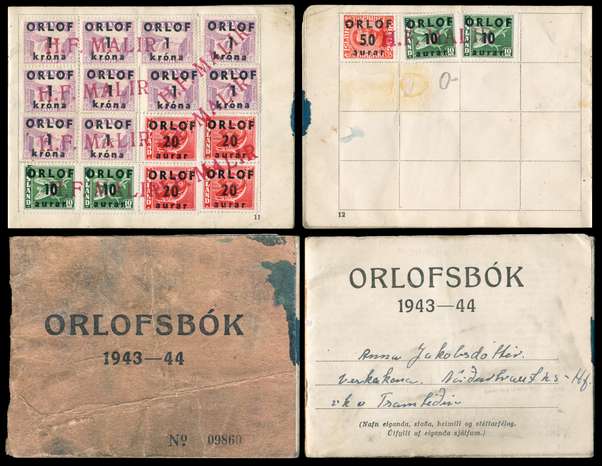|
 |
|
|
1943-44 Savings Book Containing Overprinted Stamps.
This was the first and only year (season) of use of overprinted stamps. |
|
|
|
| Iceland: Orlof Overprints in 1943-44 Savings Book |
|
by Jay Smith
This article provides background information and illustrations of a complete savings book which includes important text on the early laws and regulations regarding the holiday savings system and the orlof stamps.
Icelandic Orlof Overprinted Stamps are offered for sale on the Iceland Orlof Overprinted Stamps web page.
The Icelandic word "orlof" translates to holiday or vacation. Since at least the 1940s, Iceland has had an elaborate system to ensure that workers had some savings built up for their annual holiday. To address the special needs of part-time and seasonal workers, a savings stamp system was developed.
Thor Thorsteins has written (summarized here): A law dated February 26, 1943, required employers to pay temporary wage earners 4% vacation pay, to be paid in Vacation Stamps at the time of payment of wages. The post office was to issue Vacation Stamps and Vacation Books for the stamps. Both full post offices and the smaller letter collecting stations were to distribute the books free of charge but only full post offices were to sell Vacation Stamps and redeem books for vacation funds. Stamp sales began August 1, 1943. (Vacation pay was initially 4%; 6% from 1957; rising in 1964 to 7% and to 8-1/3% in 1971.)
Due to insufficient time to prepare special Vacation Stamps, for the vacation year 1943-44, postage stamps overprinted with the word “Orlof” and values of 10, 20 and 50 aurar; 1, 2, 5, and 10 krónur, were used. It was required that postal clerks sell these stamps to whoever desired them. These overprinted stamps were savings stamps for the next summer vacation period starting May 15, 1944 until May 14, 1945. The wages recipient was to glue the received stamps into his/her book and before going on vacation during the vacation period to present it with accompanying certification for payment at a post office. Overprinting of stamps was performed by State Printer Gutenberg during the period May 16, 1943 to April 13, 1944.
Starting in 1944, purpose-designed Vacation Stamps were printed and used up into the 1970s (these are also available from Jay Smith and Associates).
Twelve regular postage stamps and seven official stamps were overprinted. They were sold for only about nine months and were then withdrawn. Though printed in quantities of ranging from 19,700 to 158,500, most were printed in quantities of less than 50,000. Quantities withdrawn and destroyed seem not to have been recorded, thus only the original print quantities are known; some stamps may exist in much smaller quantities than the original print numbers suggest. Stamp collectors in Iceland at that time seem to have paid little attention to these stamps; collectors outside of Iceland seem to have been virtually unaware of them until many years later. Because they were not considered to be postage stamps, they got less respect at the time. Furthermore, economic conditions in Iceland during the war years were extremely difficult for many people and thus little money was spent on stamps like these. It seems that no Icelandic stamp dealers stocked them or offered them to overseas buyers. It must also be remembered that the stamps had to be redeemed to get the money for a vacation and that the post office normally destroyed the redeemed, canceled stamps. The only mint-with-gum stamps extant were likely purchased by collectors, plus perhaps the odd few found in the desk drawers of small employers. Used examples are very scarce.
Remaining research opportunities: Nothing is known about the quantities of stamps withdrawn and destroyed. (Though Thor Thorsteins has not found any quantity data on orlof stamp destruction in the postal archives, despite his extensive research, data may still exist somewhere.) Relative scarcity of the different stamps, in mint and used condition, as well as of savings books, is only anecdotal; a census of recorded examples could be very revealing. One inverted overprint is recorded -- it is a sideways overprint, thus it is not obvious that it is inverted -- perhaps other major variations are waiting to be recorded. On some issues (the 60 aur Gulfoss stamp is one of them), small differences, due to wear, in the overprint type can be found; these could be cataloged. Of the overprinted stamps, pairs and larger strips are scarce and blocks are rare; a census of these could be made. The laws & regulations text of this (and other) savings books needs to be translated at least into English.
Icelandic Orlof Overprinted Stamps are offered for sale on the Iceland Orlof Overprinted Stamps web page.
|

